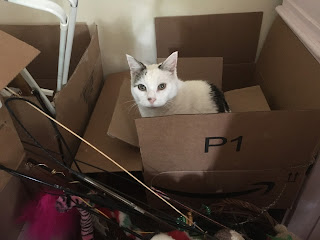Last night, on my way home from an evening kitty visit, I pulled a large tabby who had been hit out of the road and rushed him to the animal emergency center off 145th and 15th in north Seattle. He died apparently just before the doctor could asses the extent of his traumatic injuries. This was an "owned" cat or at least was at one time, as he was micro chipped. As angry as I am that a driver hit him and didn't stop, I am also angry that his so-called guardian allowed him to free-roam along Meridian Avenue. I can fully appreciate that cats need stimulation outside of their home, to smell, nibble on grass, and exercise. The hard facts however are that even the most careful driver could accidentally strike down a cat, not to mention the danger of loose dogs, coyotes, pesticides, and deranged and cruel humans.
There are safe ways to allow your kitty outdoor time. Building a catio is one option (best for the wild ones). Leash/harness training your cat is another (good for confident and young kitties). Or have supervised outdoor time where you stick with your cat like his bodyguard and he stays within your fenced yard (ideal for older cats who cannot jump). Being trained to "recall" with his favorite treats can get them indoors if you need to leave the house or for whatever reason you think it might be unsafe for them to stay out. Cats can learn the routine of when they can go out and when they need to come back in; for instance they may expect outside time when you get home from work but then they will start thinking about dinner after that. I just read
The Trainable Cat,
A practical guide to making life happier for you and your cat, by John Bradshaw and Sarah Ellis (Basic Books, 2016). This book explains how cats learn and the most common situations/behaviors guardians may want to "train" their cats for. An example is accepting a harness and walking outdoors or staying within the boundaries or the yard and "recalling" when it's time to go in. Basically, operant conditioning rewards the desired behavior and ignores or redirects the behavior you want to discourage. Spray bottles or loud noises are NEVER advised.
The Trainable Cat helps readers understand that many of the behaviors we might wish our cats didn't do, are innate and absolutely necessary to their psychological and physical health. Scratching the sofa, stairs or door frames for example are how your cat marks his territory. Placing enough of his "markers" around for him to leave his scent may prevent him from using your stuff; markers can be cardboard scratcher boxes, stable kitty condos that allow him to fully stretch and jump onto, and a variety of textures. Cramming all of your cat's items (scratcher, litter box and food and water bowls) in one small area defeats his ability to have markers and probably doesn't make him feel very comfortable. Hunting behaviors can be exercised with sensory boxes - cardboard boxes with treats and a few furry mice buried with dried leaves. Treat balls, which you load with dried treats, are a similar experience. Obviously leaving a big bowl of dry food out isn't going to encourage your cat to engage in other, more novel ways to "catch" his food!
What I like most about
The Trainable Cat is how much the authors stress patience and training at your cat's pace. This book is really about minimizing stress in you kitty's life, not teaching him party tricks. Going to the vet is often tops on the list of stressors in kitty's life. A list of features to look for at a clinic that help reduce stress for cats and helpful hints for you are discussed. We are fortunate to have so many feline-friendly veterinary practices in Seattle (see http://www.catvets.com/). Cats can experience chronic stress as well, which can lead to weakened immune systems, depression and anxiety. Regardless of your decor, kitties need places to climb (large kitty condos), to hide (boxes, large baskets, re purposed furniture), to sleep (at least several beds to choose from), windows where they can watch other animals or people and feel sunlight, and active time with you, either playing, cuddling or grooming. Bringing in kitty grass, new treats (buy some liver at the store or cook some fish or chicken every so often just for the kitty) and new toys can help keep boredom at bay.
I think
The Trainable Cat is a great resource for both new and experienced cat guardians. It gave me some new insights and ideas. "You should think of training not as interfering with your cat's freedom but as a way of channeling his desire to learn towards making his life, and your relationship with him, as good as it can be," comment the authors. I am all about making kitties happy!



















